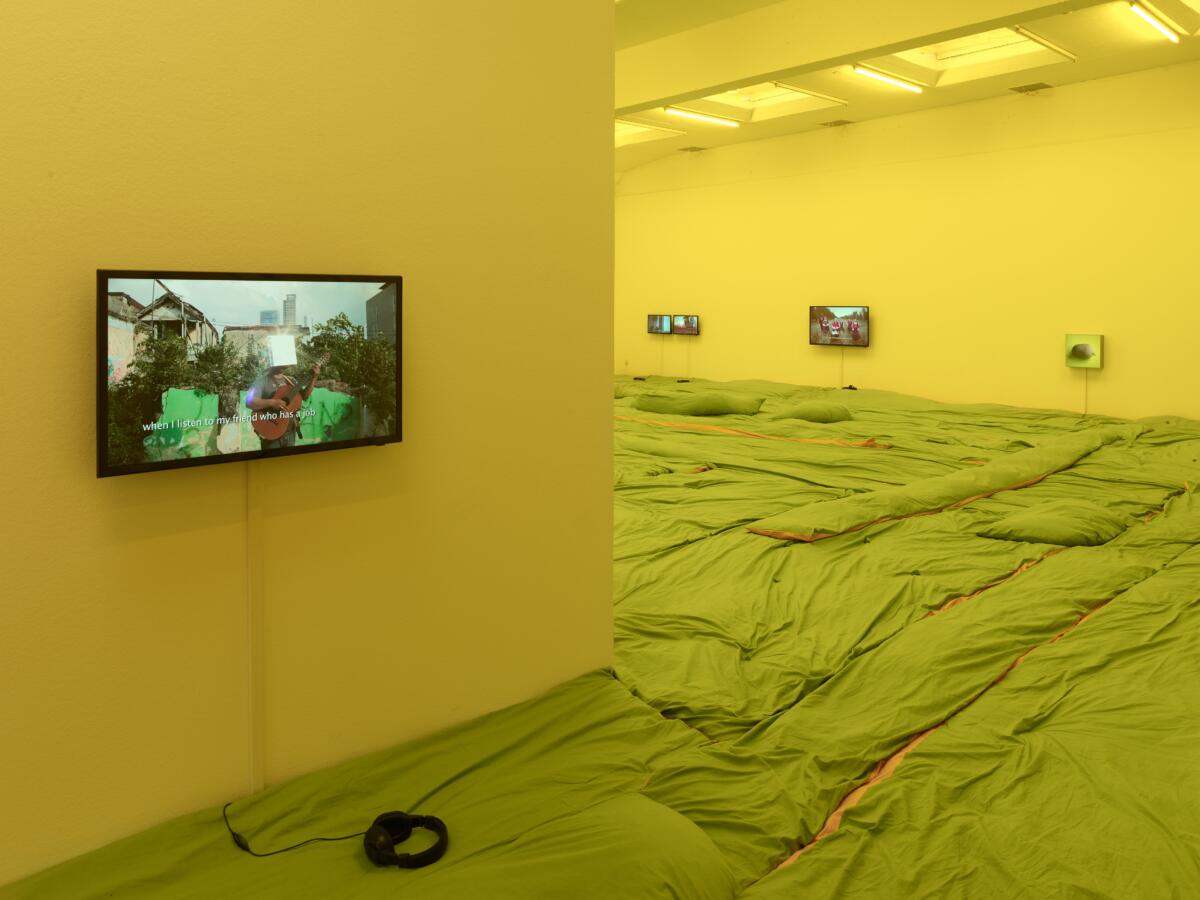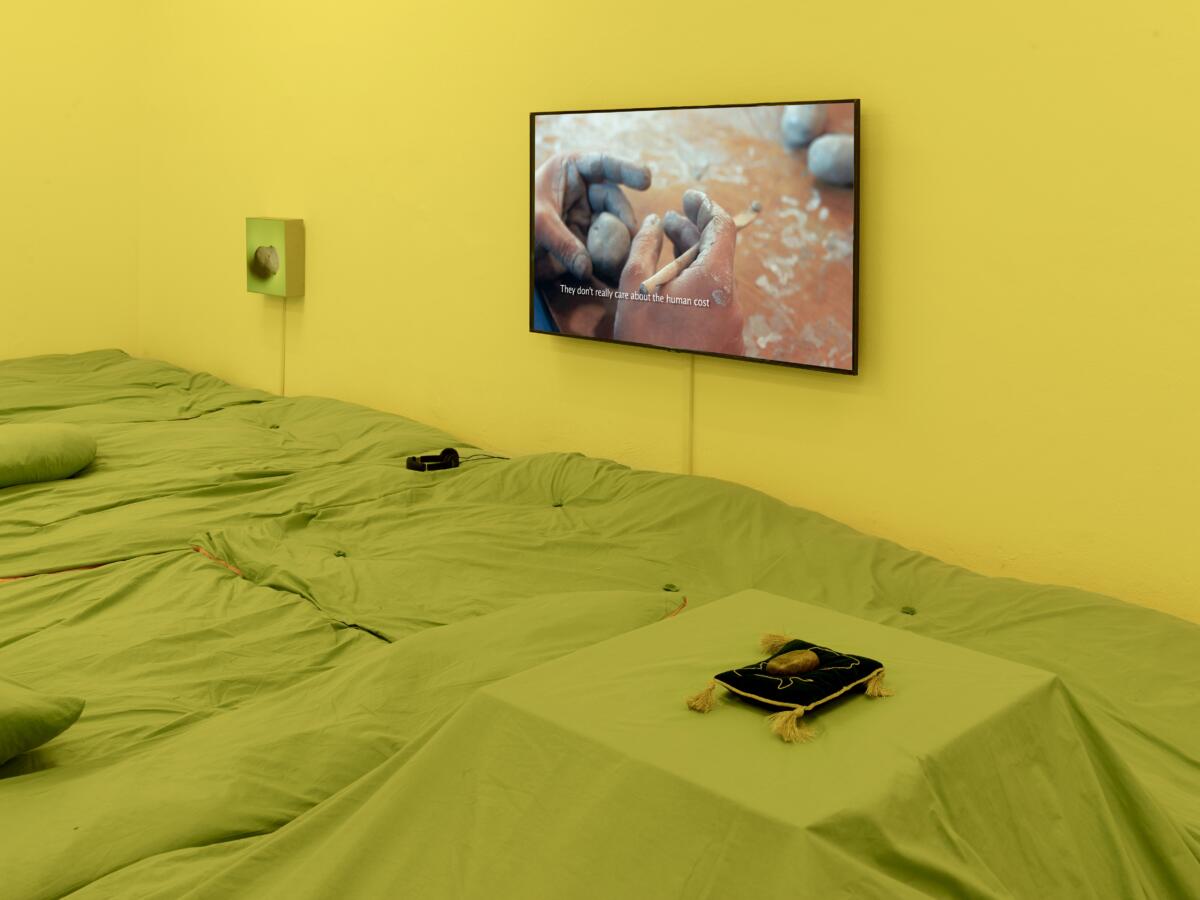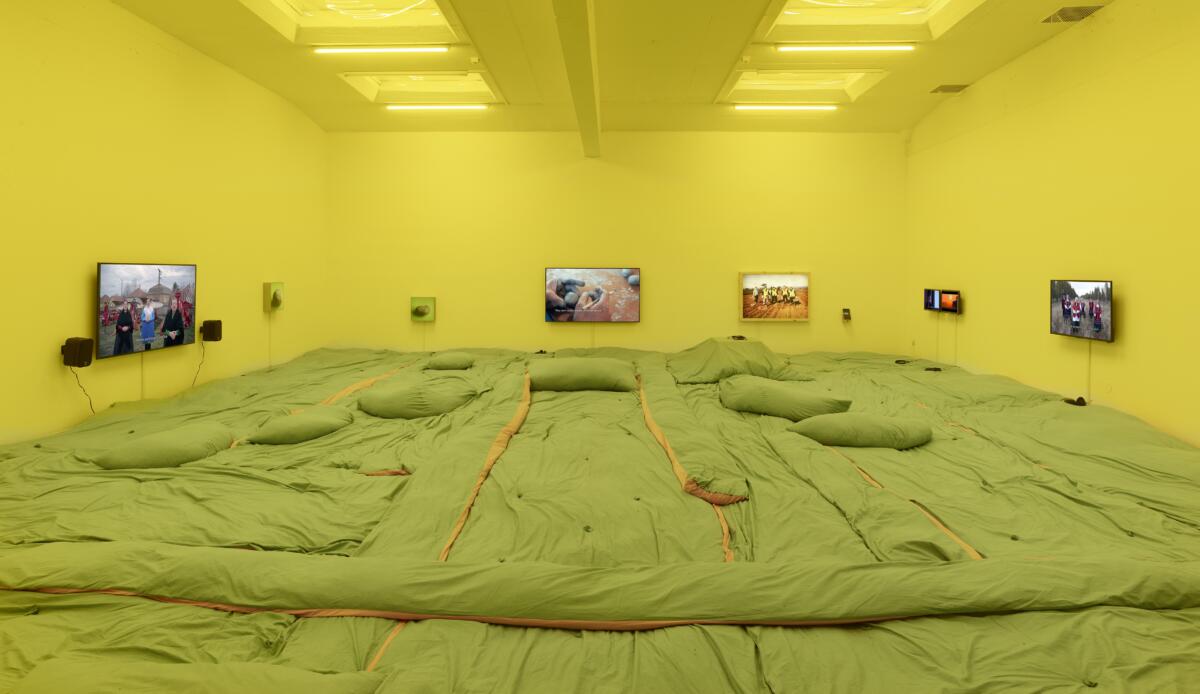
At the entrance of Temporary Gallery in Cologne, visitors are greeted by a lifesize photograph of what resembles a statue. Living actors outfitted in blue work overalls stand motionless on a platform in a public park. Frozen in various unnatural, contorted poses, the mass becomes an uncanny monument to wage work. Or to be more precise, to service, which is endowed with invisible gestures, movements, and actions, now obscured by stillness. In lieu of the Socialist monuments and propaganda images of the anonymous but heroic figures of the working class or peasantry, the curious snapshot created by Polish artist and activist, Alicja Rogalska, choreographs the immeasurable subterrain of the neoliberal era. Rogalska’s work intricately incorporates and juxtaposes the multipolar contemporary world of exploitation by creating and by organizing different narratives around communities primarily coming from former Warsaw Pact states.
The exhibition, curated by Aneta Rostkowska, consists chiefly of video works which are documents of Rogalska’s different artistic strategies. The brightly lit main room is filled with light green straw-filled pillows which create an eerie, spacious atmosphere. This artificial comfort is contrasted with the palpable sensation created by the pillows strewn about, inviting one to sit and watch the video works that encircle the room. This juxtaposition of inorganic and organic matter, and hints to agricultural work, is present in many of Rogalska’s works.
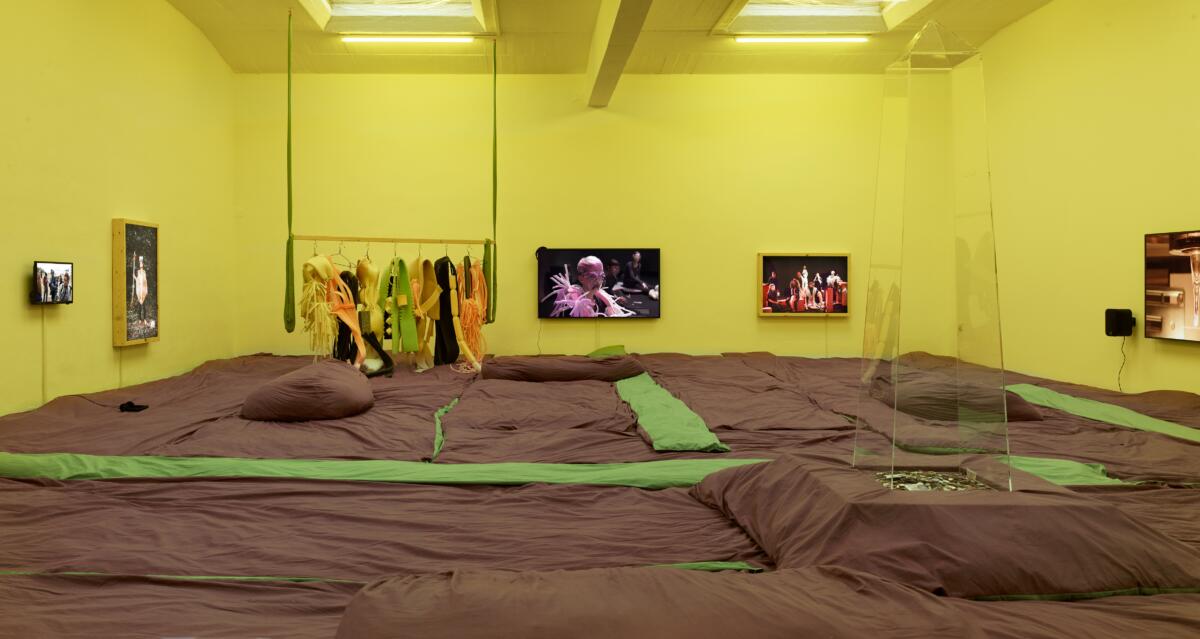
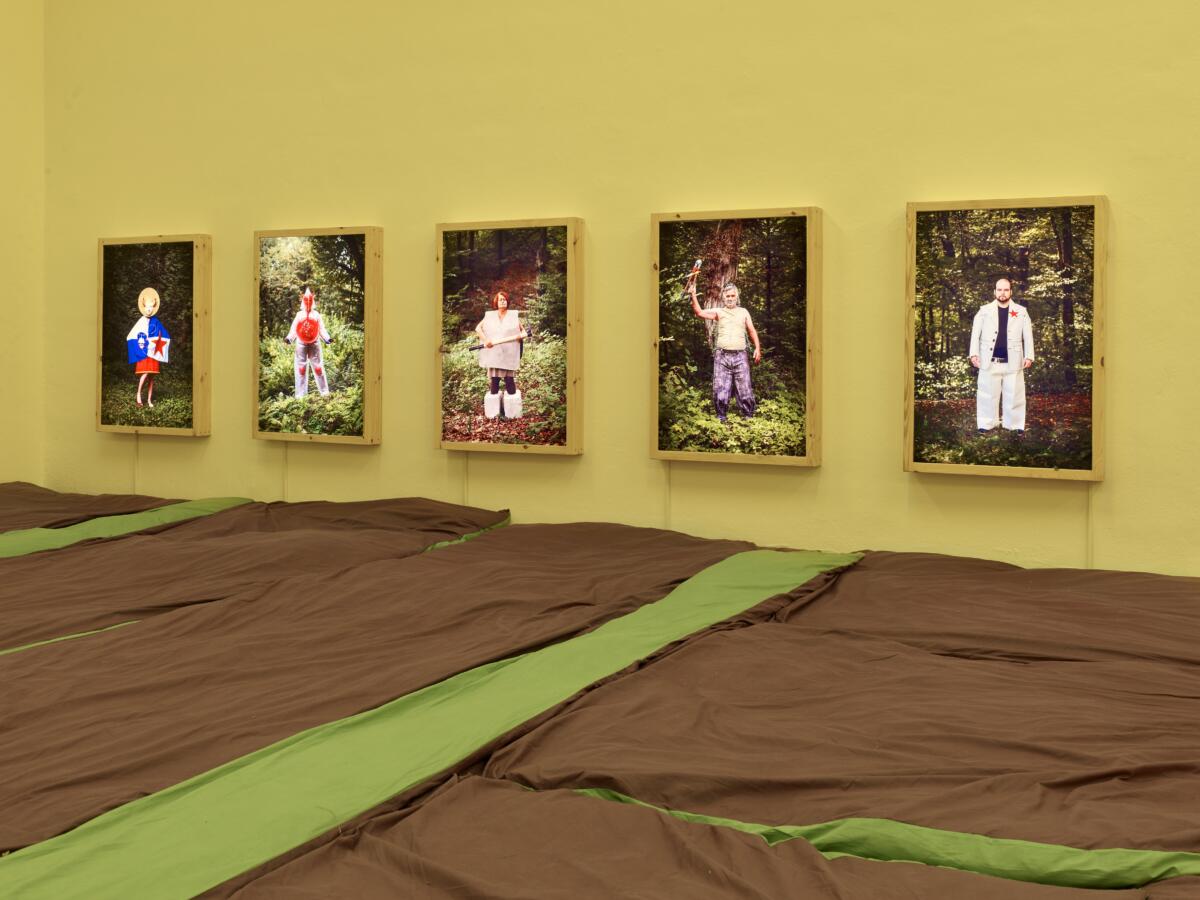
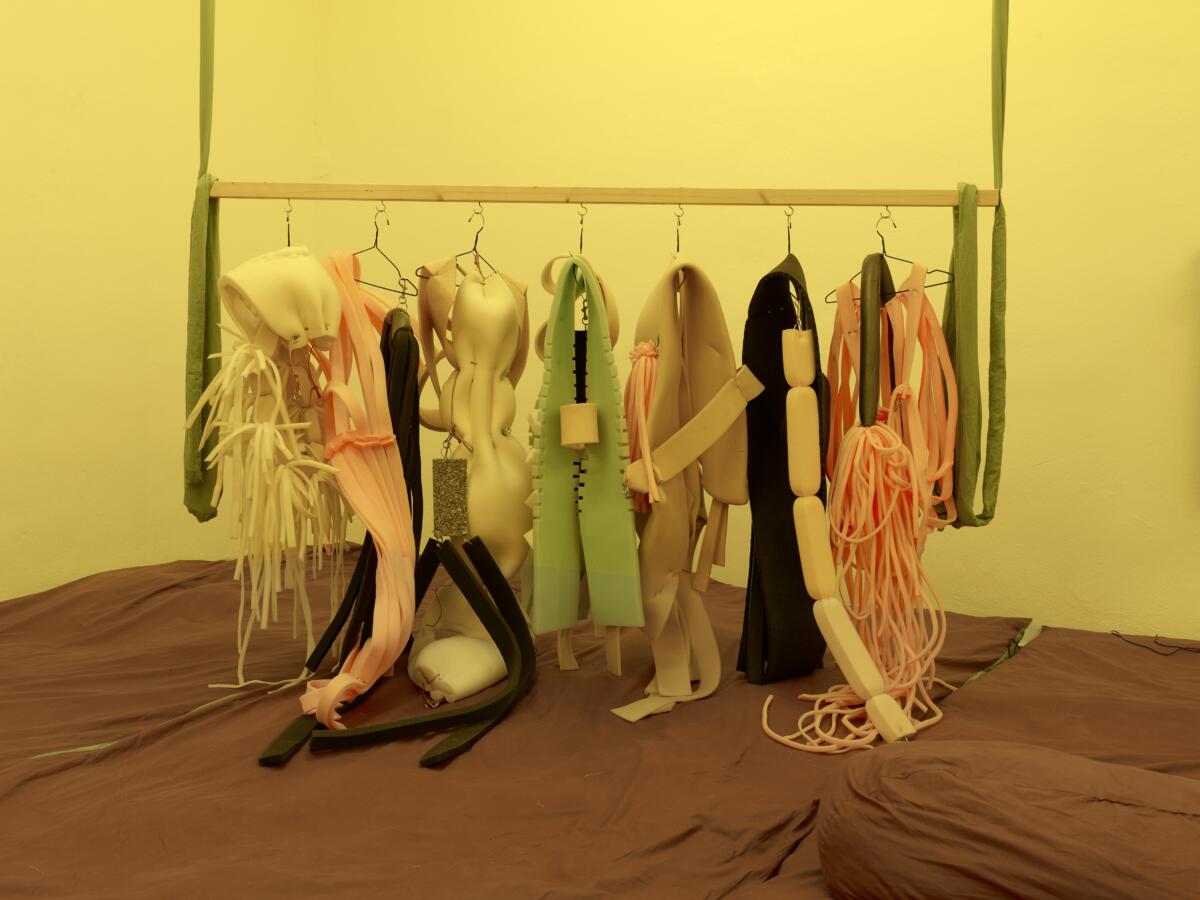
The neoliberal order has erected its own fractured monument by achieving world dominance, and what has been christened “internal colonialism”, subjugating every token of life under the regiment of labour – even gestures, smiles, and emotions have entered the irrevocable realms of value and exchange. Officially, the so-called liberalization or marketization of society after the collapse of the Iron Curtain was touted for bringing forth the merits of wealth, equality and freedom. Who’s going to erect a monument to the victims of the market? There is a glass obelisk in Warsaw which functions as a station for collecting money for such a monument. Monument to the Victims of Capitalism (2016), which is an ongoing, partly virtual project, archiving different designs for such a monument, which Rogalska’s work refers back to.[1]
Francis Fukuyama famously proclaimed that the market is the final monument, the pinnacle of social evolution. Although this narrative has been full of ruptures from the very start, it was only in the last decade that it demonstrably came under attack.[2] As the state was trying to soothe a global financial crash, and later a global pandemic, in order to hold on to its alleged market order, the West and the East alike ushered reactionary proto fascists and psychopaths into state politics. What was swept under the rug in this principally Western narrative was first and foremost the experience of those who were new to this freedom, such as the peoples and cultures of the former Soviet bloc states.
How did they experience this revolution that turned out to be, as in the West, the neoliberal revolution? How did their lives change? Economically, collectively and individually, how was everyday cultural practice affected?
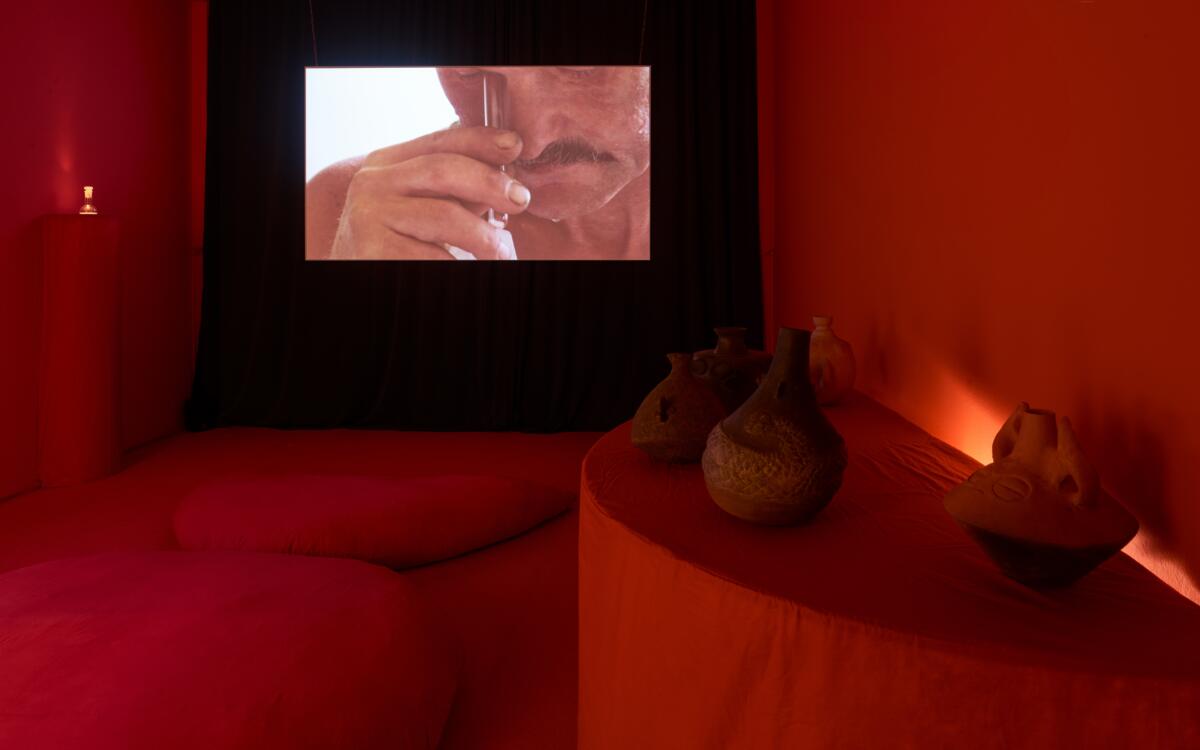

In Rogalska’s piece Tear Dealer from 2014, lamentation and grief is slanted at an idiosyncratic and ostensibly cruel angle. A shop in a market district in the city of Lublin, in southeast Poland, offered to exchange tears, 25€ for 3 milliliters. The perverse valorisation of emotions is a nod to the un-shed tears, the hidden grief for the lost moments and drudgery of the subaltern.
Dead labor was the term Marx chose to describe the uncanny and abstract property of wage labor, that is the appropriation of time, movements, and energy that is concealed in every product. The quasi-substance of value and wealth, the commodity, conjoin innumerable and nameless people working in unknown places. As much as the commodity expresses a need or desire, value or wealth, it conceals the arduous experiences of its creators.
Regarding the present-day prominence of supply chains – as the blood circuitry of the global order begins to leak– one can conceive of these chains as the expression of a global division of labor – desire, design and planning on one side (the global west), and the coercion of labor, an intersectional pecking order, “the body”, on the other side of the world.[3]
The rosy ideal of Western consumer culture comes at a price, yet in both the West and the East it still remains an unrealized, hazy dream for most people. The more the hybrid global machine of capital accumulation reaches into every fissure of life, the more it connects us. At the same time it severs the ties of our collective experience from the unknown subaltern. Just as it alienates us from our own experiences of exhaustion through work (as is evident in the so-called phenomena of burnout, the feeling of senselessness, the sickness of depression, that somehow remain taboo and undiscussed in broader contemporary culture, as Mark Fisher incessantly reminds us). The universality of the market neglects the universality of peoples and their expression, since the “global” narrative is almost invariably provided by the West and its agencies. We witness, as much as production and commodity transport is unscathed by borders, how people are still separated on the grounds of nationalisms and racist ideologies.
Rogalska’s work with the Hungarian female choir of Kartal deals with the representation of traditional roles of peasant women, by rearranging traditional songs and lyrics. Here, a collective and democratic process enabled the artist, curator Katalin Erdődi, and folk singer Réka Annus, to collaborate with the choir by taking part in the arrangements and rehearsal. As the folk song unfolds, the video shows women of different generations in traditional clothing singing in front of what might be a peasant farm house, next to an agricultural tractor. In the lyrics as well as in the setting, once again, traditional and modern topics are juxtaposed. In the words of the Polish anthropologist Tomasz Rakowski from the documentation of the work:
“I am convinced that these examples reveal a social enthusiasm, a kind of social subjectivity that brings us closer to understanding the informal underpinnings of civil society, not as an objective social fact, but rather considered from an anthropological point of view.”[4]
The melancholic song represents the mourning of the past, where women had no choice but to be subject to their husbands. But at the same time, it acknowledges the freedom of young women today. They sing about the commitment and housework that was demanded of them. Tradition provides the braid to address and refocus the past anew, challenging the very idea of cultural heritage as an artifact belonging to the past. It also reanimates the ties of the community through an open discourse within the circle of women.
Here, the traditional formula of choir practice is in itself presenting an active medium of expression for women recollecting their histories. Hence the name News Medley[5], which emphasizes the active and emancipatory character of the historic medium of the women’s choir, which survived the socialist period and still exists in the neoliberal present. The performance in the video exists in itself as another medium. In quasi-reversed roles, we witness an account of history that renders itself a medium by watching the women telling their story.
Another video shows the documentation of a film festival for “short agricultural videos” (Cultivation. Festival of Short Agricultural Videos, 2015). The representation of farmers as primitive and backward people, prevalent after the fall of the Soviet Union, is contrasted with the short Youtube videos of young Polish agricultural workers.[6] In Rogalska’s video we see pop charm and pride accompanied by dance music and sometimes comical scenes of work and machines. The soundtrack consists of weird echoes, vaguely reminiscent of the bizarre state representation of peasants and workers in communist media. While farmers have at times been regarded as a set back to Soviet modernization, the crude depiction of agricultural labor in the official socialist propaganda spoke another language. This time, however, it is the peasants who are taking charge of the narrative of their work. The festival invited farmers from a young, vibrant internet-based community in Poland to upload their videos to be shown to a broader public.
In many of her works, Rogalska is addressing collective forms of expression. Not by appropriating cultural narratives but by working with communities, accompanying them in the development of their own stories. Similarly to ethnological practice and documentation, tradition can be a vehicle for both reflection on the past and rumination on a different possible future, therefore expanding the archive whilst also producing a culture of yet unseen reflections. The everlasting present of the so-called “end of history” is revealed as a hoax. In Rogalska’s view, culture is the only means of expression of history and experience that might serve as a basis for a shift in the dominant narrative.
The hybrid forms that labor takes on in the context of service, for example domestic and care work, but also in various other forms of cognitive and immaterial labor, can only be encountered with a hybridization of the narrative and context, enabling us to articulate and negotiate experience, to learn to speak and find ways to listen. In a way this missing articulation of experience can be seen as a prevailing trauma. Not speaking, not reckoning, not understanding, not connecting, not establishing a novel perspective or vision. In that regard, Rogalska’s practice in many ways can be interpreted as collective trauma work.
We need an individual and collective past to gain a future, just as we need to establish a cultural practice of appreciation to come to terms with the present. As we experience the disruption of the supply chain – a temporary, insignificant loss of wealth from the Western perspective – who is going to speak or estimate the real impact of the crisis if not the marginalized and dispossessed? The ineptitude of the liberal elite to find a language for the defects of the market is contrasted by countless attempts of the subaltern to find ways to speak and time and time again, to express what was and has been lost.
The appropriation of history and the subduing of it within the grand narrative, in the West as in the East, has forstalled any alternative paths, neglecting the everyday struggles and practices of the many. This brings to mind an essay written by Maximillian Alvarez for the Boston Review: “We are now fighting on terrains where the old rules of historical warfare no longer apply. In the hypermediated reality of an endless political now, the meaning of history is determined and enforced not by the myriad monuments reminding us of our past, but by those who employ enough blunt force to occupy our attention in the present.”[7]
One can argue that the contemporary art scene has the potential to change dominant narratives, with works such as those of Rogalska, evidently foreshadowing practices that reconnect the effects of the neoliberal regime with its own unconscious by activating memory and communication as a means of experience. The artist lets the many voices of the subaltern speak. In her show at Temporary Gallery, Alicja Rogalska creates a choir that oscillates between the past, present, and another possible future, and establishes new ways of thinking about the social and the communal.
Edited by Ewa Borysiewicz and Katie Zazenski
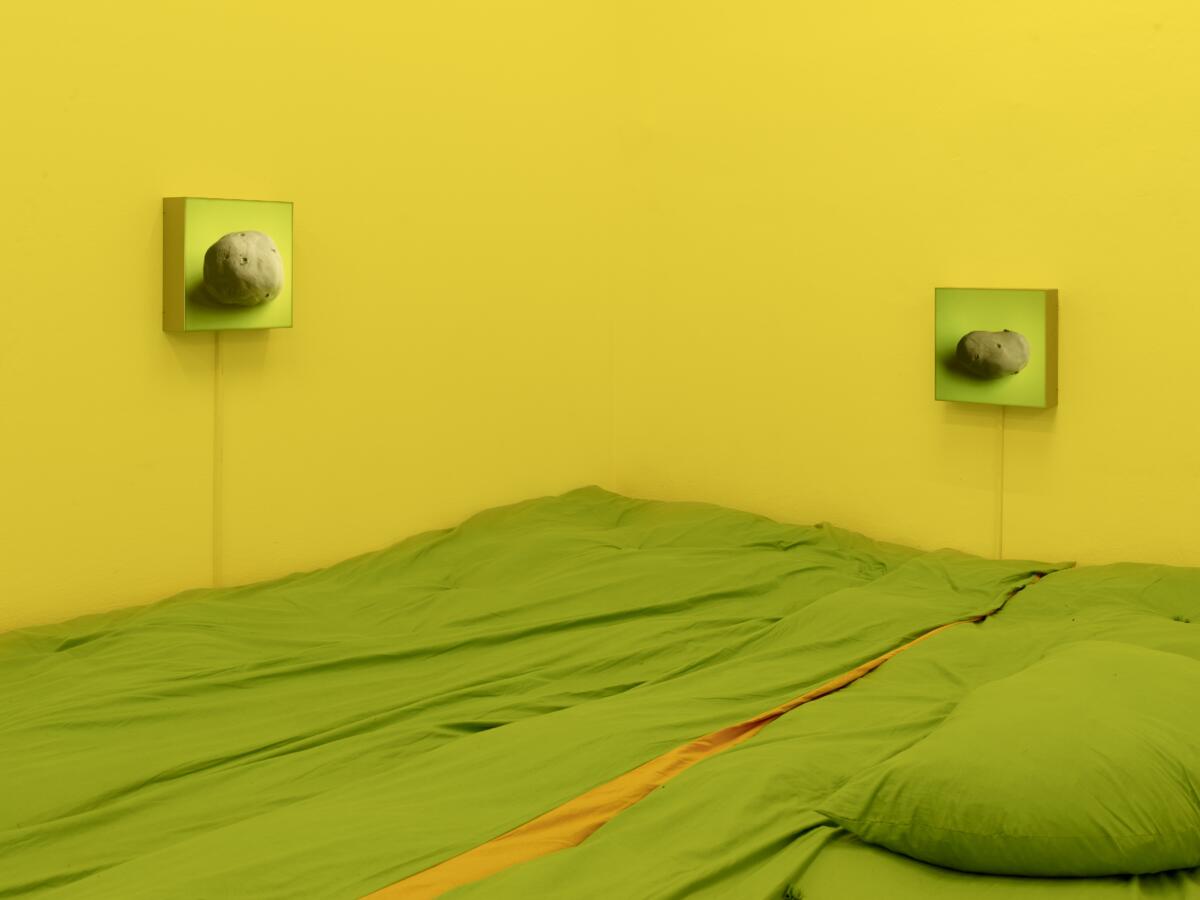
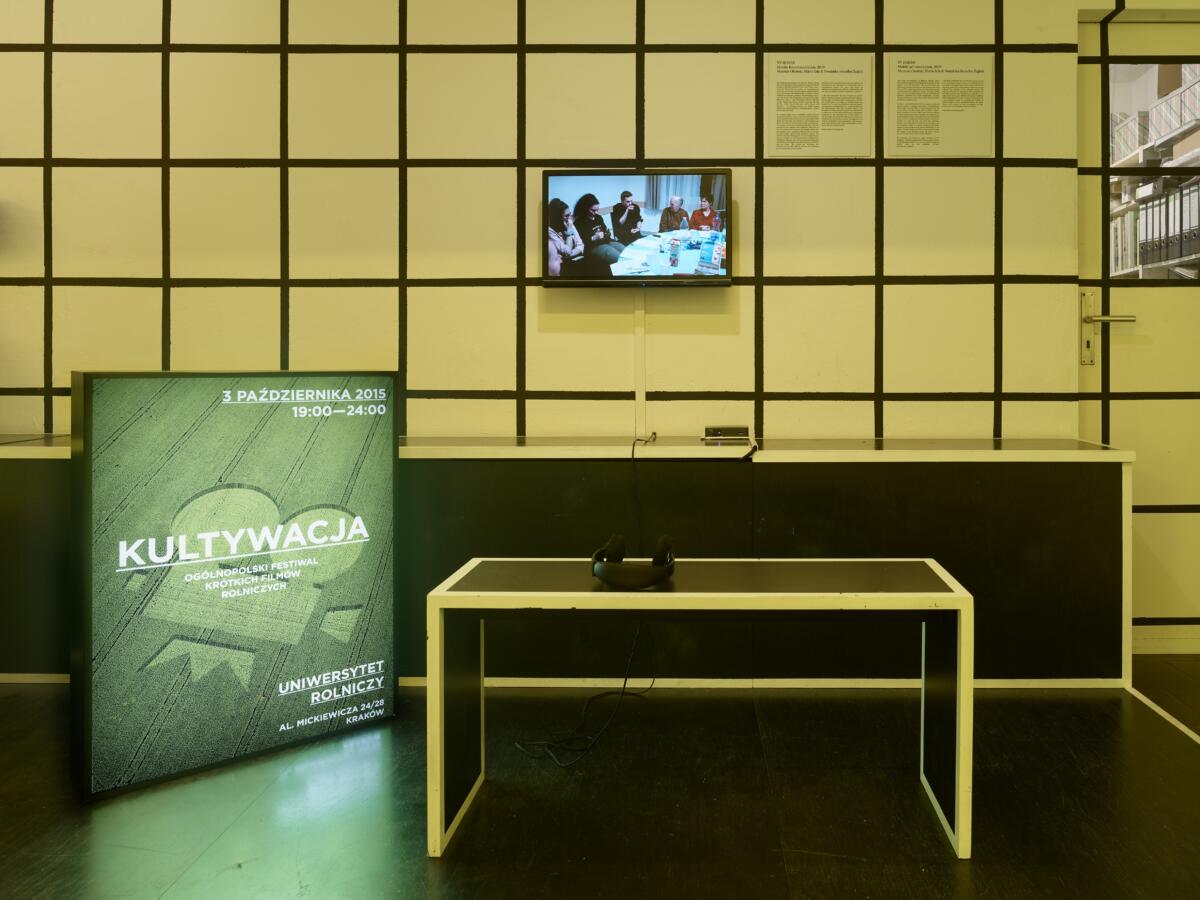
[1] http://monumenttovictimsofcapitalism.org/
[2] Fukuyama himself was more gloomy towards the teleology and the alleged end of the political or depoliticisation as is often recognized. See: Alex Hochuli, George Hoare and Philip Cunliffe: The End of the End of History. Politics in the Twenty-First Century. Zero Books 2021.
[3] Anna Tsing: Supply Chains and the Human Condition. In: Rethinking Marxism: A Journal of Economics, Culture & Society, 21:2, 148-176, DOI: 10.1080/08935690902743088
[4] See the brilliant catalogue, documenting the work: NEM CUKORBÓL VAGYUNK, HANEM BETONBÓL – WE ARE NOT MADE OF SUGAR, WE ARE CONCRETE. Edited by Katalin Erdödi and Alicja Rogalska. Published by ART AT WORK Vienna, ONCURATING.org, Zurich, and OFF Biennale Budapest 2021. ISBN: 9798748518710
[5] 2020, premiered online at OFF Biennale, see: https://kajetjournal.com/2021/05/28/news-medley-erdodi-rogalska-annus-kartal/
[6] After the fall of the Iron Curtain that tendency of viewing the farmers as backwards and primitive became prevalent as Tomas Rakowski says in the catalogue (see: footnote 4): “Recently in Poland, a recurring ‘internal colonization’, an internal stigmatization of villagers can be observed, that is articulated in a sort of social contempt towards their past experiences, as Polish anthropologist Michal Buchowski has noted as early as 2006. He sharply observed how after the transition of the 90’s the often poor and powerless former state farm workers were described in public discourse as uncivilized and thus created the ‘new others’. Therefore, it is particularly urgent to confront and oppose such views on the history of socialist modernization.” p. 41.
[7] Maximillian Alvarez: The End of the End of History. In: Boston Review. March 25, 2019. https://bostonreview.net/articles/maximillian-alvarez-end-end-history/ (22.03.11)
Imprint
| Artist | Alicja Rogalska |
| Exhibition | From Ground to Horizon |
| Place / venue | Temporary Gallery, Cologne |
| Dates | 13 November 2021 — 30 April 2022 |
| Curated by | Aneta Rostkowska |
| Photos | Simon Vogel |
| Website | www.temporarygallery.org/en |
| Index | Alicja Rogalska Aneta Rostkowska Marco Schröder Temporary Gallery |


